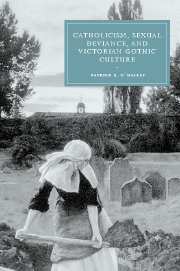Book contents
- Frontmatter
- Contents
- List of illustrations
- Acknowledgments
- Introduction: skeletons in the cloister
- 1 Goths and Romans: the literature of Gothic from Radcliffe to Ruskin
- 2 “The Church's closet”: Victorian Catholicism and the crisis of interpretation
- 3 Domestic Gothic: unveiling Lady Audley's Secret
- 4 The blood of the saints: vampirism from Polidori to Stoker
- 5 “Monstrous and terrible delight”: the aesthetic Gothic of Pater and Wilde
- 6 Conclusions: Oxford's ghosts and the end of the Gothic
- Notes
- Works cited
- Index
- CAMBRIDGE STUDIES IN NINETEENTH-CENTURY LITERATURE AND CULTURE
5 - “Monstrous and terrible delight”: the aesthetic Gothic of Pater and Wilde
Published online by Cambridge University Press: 06 July 2010
- Frontmatter
- Contents
- List of illustrations
- Acknowledgments
- Introduction: skeletons in the cloister
- 1 Goths and Romans: the literature of Gothic from Radcliffe to Ruskin
- 2 “The Church's closet”: Victorian Catholicism and the crisis of interpretation
- 3 Domestic Gothic: unveiling Lady Audley's Secret
- 4 The blood of the saints: vampirism from Polidori to Stoker
- 5 “Monstrous and terrible delight”: the aesthetic Gothic of Pater and Wilde
- 6 Conclusions: Oxford's ghosts and the end of the Gothic
- Notes
- Works cited
- Index
- CAMBRIDGE STUDIES IN NINETEENTH-CENTURY LITERATURE AND CULTURE
Summary
He finds the objects of his love along the path of narcissism, as we say; for Narcissus, according to the Greek legend, was a youth who preferred his own reflection to everything else and who was changed into the lovely flower of that name.
Sigmund Freud, Leonardo da Vinci and a Memory of His Childhood (1910)It is the spectator, and not life, that art really mirrors.
Oscar Wilde, “The Preface” to The Picture of Dorian Gray (1891)Despite the ambiguities of their endings, both Carmilla and Dracula (like Lady Audley's Secret before them) rely on the phobic tropes that the Gothic of Ann Radcliffe and Matthew Lewis had put into circulation. Their logic of fascination requires that the objects of that fascination (Catholicism, lesbianism, the erotics of vampirism itself) be recognizably evil, something to be desired precisely because it must be feared. There is, however, by the later years of the nineteenth century an alternate understanding of vampiric Catholicism, one which still draws its metaphorical structures from the traditional Gothic and yet reverses the cultural valence of those structures. While Sheridan Le Fanu warns that the vampire, with all of its religious and sexual deviances, is literally at the drawing-room door of contemporary British culture, Walter Pater counters with the notion that a new Aestheticist Gothic provides opportunity rather than despair.
- Type
- Chapter
- Information
- Catholicism, Sexual Deviance, and Victorian Gothic Culture , pp. 165 - 192Publisher: Cambridge University PressPrint publication year: 2006



